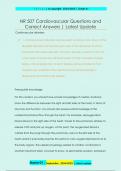Exam (elaborations)
NR 507 Cardiovascular Questions and Correct Answers | Latest Update
- Course
- Institution
Cardiovascular disorders ~~>Cardiovascular disorders are prevalent in primary care. Many of the disorders develop over several years, due to the risk factors to which individuals have been exposed. For each disorder covered in this unit, a discussion of risk factors will be included. For...
[Show more]



